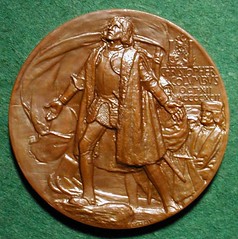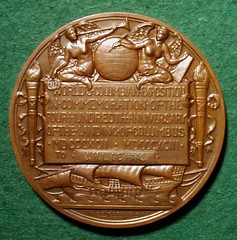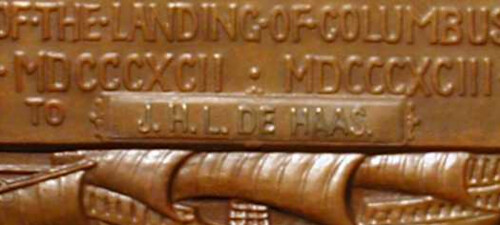
PREV ARTICLE
NEXT ARTICLE
FULL ISSUE
PREV FULL ISSUE
V25 2022 INDEX E-SYLUM ARCHIVE VOCABULARY TERM: INSERT DIEHere's another entry from Dick Johnson's Encyclopedia of Coin and Medal Terminology. I've added images from an earlier E-Sylum article of a medal found on Ben Weiss' Historical Art Medals site. Thanks again! -Editor Insert Die. A special die and its supplemental part – an insert – employed to produce raised lettering on a medal. The die to contain the insert is machined with a cavity by a tool and diemaker. The cavity is somewhat boat shaped with bevel sides. The insert blank is made of steel, also by a tool and diemaker it is shaped to fit the cavity in the insert die The insert blank is then engraved incuse by a hand or machine engraving to contain the desired lettering. During striking the insert lies loose in the base die – only one side of a medal may have an insert and this die must be in the lower position in the press (it would fall out of the die in the upper position). Raised lettering is produced by this method, but always a tiny raised ridge outlining the insert appears as flash on a piece so struck; this line is diagnostic of the use of an insert. It may be removed by chasing on the struck piece if considered too obvious and unwanted. A small or large quantity of medals with raised lettering can be made efficiently by the use of inserts from one setup of the press. Each insert must be engraved separately with the recipient's name and placed by hand in the insert die before striking. The award medals of the Columbian Exposition, for example, were struck by insert dies. The first use of insert dies in America occurred during the Civil War. Numismatist Q. David Bowers found this technology was employed by Boston diesinker Joseph Merriam in 1863. From 1870s to 1920s billiard supply manufacturers provided tokens to their clients with their name (and sometimes the denomination) struck by insert die on the reverse. The tokens bore the advertisement of the billiard company on the obverse. Over two dozen such firms made tokens for use by billiard parlors, the tokens often bore an illustration of a pool table. Any piece struck by an insert die without its insert would contain a large shapeless raised lump resulting from the cavity. On the opposite side would be a depression or ghosting effect as metal in the blank is drawn toward the cavity. See dies and diemaking. Columbian Exposition Award Medals Made with Insert Dies The most famous use of insert dies was for the Columbian Exposition Award Medal with obverse by Augustus St-Gaudens and reverse by Charles Barber (Eglit 19 and 90). These were ordered made at the U.S. Mint. But Columbian Exposition officials insisted the recipient's name be in raised lettering within the cartouche in the lower part of the panel on the reverse. The Mint made the dies but quickly realized they could not produce the quantity of such medals desired by fair officials. So the Philadelphia Mint subcontracted the job of manufacturing these medals to Scovill Manufacturing Company of Waterbury Connecticut. It was not an easy job. I suspect Scovill demanded hubs from the Mint or made their own hubs once they got the dies on hand. (This is the cheapest form of insurance for such a long run of medals – something is bound to happen to a die in such case – it is easy to make new working dies from hubs on hand.) First a cavity had to be made in the reverse die. This was done by a tool and diemaker. Then a large quantity of insert blanks had to be made the exact size and shape of that insert cavity. I suspect Scovill die struck these because of the large number needed. The insert blank must fit snugly into that cavity. The insert blanks would then be heat treated to the proper hardness for engraving. Then each separate name would be engraved with the proper letters of the recipient's name. Not only were these medals awarded to individuals, but also firms, organizations – both private and governmental – even countries! It probably required two or three engravers full time to keep ahead of the pressmen. A crew of at least four people – two engravers, a pressman, and a clerk – were required to produce the medals. Each name had to be engraved on the insert blank, a clerk had to check the accuracy of the lettering and record this in a journal. The approved insert would then be passed off to the pressman who would remove the previous insert and position the next insert into the die, then strike the medal. At least one press was dedicated to this one job alone. All told, it took Scovill eighteen months to complete the striking. The order was for 23,000 medals! It is little wonder some recipients did not receive their medals until nearly two years after the fair was over. Amazingly, one of the two journals with recipients' names, still exists in the Scovill Company archives at the Baker Library at Harvard University, Boston. The oversize journal contains the manuscript entries of names.
To read the complete entry on the Newman Numismatic Portal, see:
To read the earlier E-Sylum article, see:
Wayne Homren, Editor The Numismatic Bibliomania Society is a non-profit organization promoting numismatic literature. See our web site at coinbooks.org. To submit items for publication in The E-Sylum, write to the Editor at this address: whomren@gmail.com To subscribe go to: https://my.binhost.com/lists/listinfo/esylum All Rights Reserved. NBS Home Page Contact the NBS webmaster 
|



